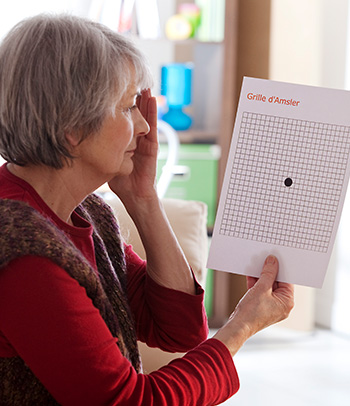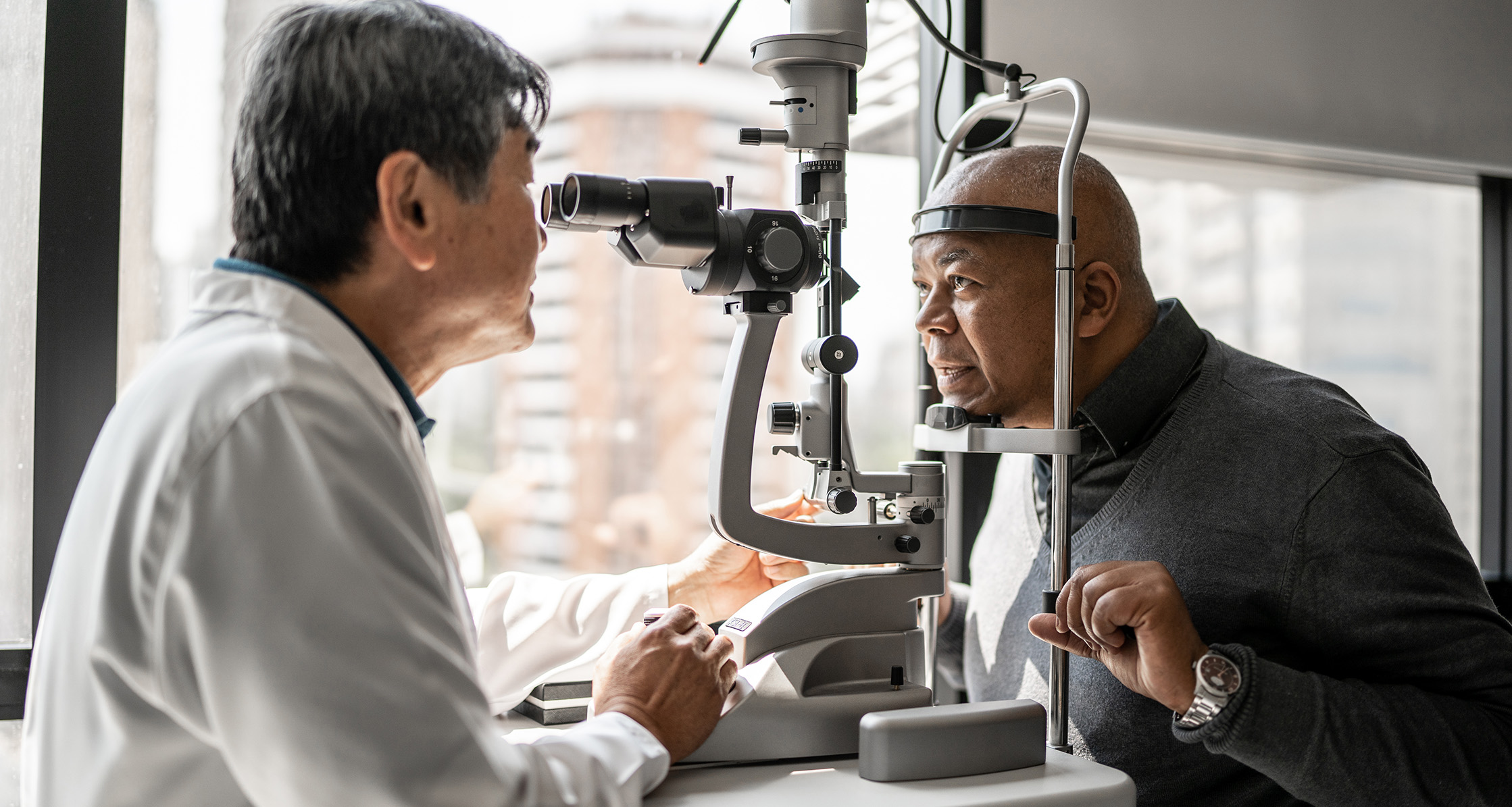When age-related macular degeneration is found early, you can slow its progression and take steps to manage its impact.
As we get older, we begin to notice changes in our health. Maybe it’s your knees feeling stiff in the mornings or some new gray hairs or wrinkles. Maybe you’re pulling the newspaper or your phone a little closer to read it. These changes are a normal part of getting older, but some changes to your health, including certain changes in your vision, are more serious and need your attention.
Age-related macular degeneration (AMD) is a leading cause of vision loss in the United States. When it’s found early, you can slow its progression and take steps to manage its impact. Learn more about this common eye disease, its symptoms and what lifestyle changes you can adopt to decrease your risk for it.
What Is AMD?
AMD is an eye disease that affects the central part of your retina called the macula. This is the part of the eye that controls your central, detailed vision. AMD doesn’t cause complete blindness, but losing your central vision can make it harder to see fine details or faces, read, drive, or do other activities like cooking or housework.
There are two types of AMD: dry and wet.
Dry AMD is the most common type. About 8 out of 10 people who have AMD have the dry form. Early on, changes in vision may be hard to detect, but over time your central vision may slowly worsen. You may see wavy lines or blank spots in the center of your vision.  Colors may also look dim. The dry form usually progresses slowly over several years, but it can progress into the wet form if it’s not closely monitored.
Colors may also look dim. The dry form usually progresses slowly over several years, but it can progress into the wet form if it’s not closely monitored.
Wet AMD is less common than dry, but it’s more serious. Vision loss may be faster and more noticeable. You may suddenly see dark spots, blank spots, wavy lines and dim colors in the center of your vision. When it’s found early, certain treatments may slow further vision loss or even improve your vision.
Who is At Risk for AMD?
Anyone can develop AMD, and everyone’s risk increases as you get older, but according to the American Academy of Ophthalmology, some people are more likely to develop the condition, including people who:
- Eat a diet high in saturated fat
- Are overweight
- Smoke
- Are over 50 years old
- Have high blood pressure or high cholesterol
- Have a family history of AMD
- Have heart disease
- Are Caucasian
If you’re at risk for developing AMD, it’s important to talk to your health care provider about your risk factors and get regular eye exams to monitor your eye health.
What Are the Symptoms of AMD?
In its early stages, it doesn’t have any symptoms, but AMD is a progressive disease, which means symptoms usually appear and get worse over time.
If you do experience symptoms, they may include:
- Mild blurriness in your central vision
- Trouble seeing in low lighting
- Straight lines starting to look wavy or crooked
- Colors appearing less bright than before
Many people don’t realize they have AMD until their vision is very blurry, which is why it’s really important to have regular visits to an eye doctor for checkups. They can look for early signs of the disease before you have any noticeable vision problems.
How Is AMD Diagnosed?
AMD can be diagnosed during a comprehensive eye exam. The ophthalmologist will use painless eye drops to dilate your eyes and widen your pupils in order to see any changes to your retina or macula. The ophthalmologist may also ask you to look at an Amsler grid. This grid helps you notice any blurry, distorted or blank spots in your field of vision. The ophthalmologist may also use a machine to get detailed images of your retina.
What is the Treatment for AMD?
There is no cure for AMD, so if you’re diagnosed with it, you and your ophthalmologist will discuss what treatment options may be available. Treatment depends on the type of AMD you have and how far it has progressed.  Your ophthalmologist will discuss possible medications, nutritional supplements and lifestyle changes that may help. In certain cases, laser surgery is a possibility as well.
Your ophthalmologist will discuss possible medications, nutritional supplements and lifestyle changes that may help. In certain cases, laser surgery is a possibility as well.
You can also discuss ways to make the most out of the vision you have with visual aids, therapy and more.
What Steps Should I Take to Keep My Eyes Healthy?
A healthy lifestyle, a nutritious diet and routine eye care can all help prevent serious eye issues. Consider these preventive steps to keep your eyes healthy and lower your chances of developing AMD:
- Get regular eye exams. The Centers for Disease Control and Prevention (CDC) estimates that half of visual impairment and blindness can be prevented through early diagnosis and timely treatment. A simple, routine eye exam can help prevent and detect vision loss, ensure your eyes look healthy and allow providers to spot other health problems as well.
- Quit smoking or don’t start. People who smoke cigarettes are up to four times more likely to develop AMD than people who don’t smoke. Learn more about quitting and how to get started.
- Get regular physical activity. Certain eye conditions, such as AMD, are associated more with low levels of activity, and emerging research suggests exercise may help improve the health of the blood vessels in your eyes.
- Maintain healthy blood pressure and cholesterol levels. The CDC says this can help lower your risk for AMD and also help prevent the dry form of the disease from progressing to the wet form.
- Learn more about your family history and share it with your health care providers. You’re more at risk for AMD if a family member has been diagnosed, so it’s important to let your health care team know about any conditions that run in your family.
- Eat eye-healthy foods, including leafy green vegetables and fish.
 Certain nutrients, such as vitamins C and E, are important for your eyes. Check out Add These Foods to Your Diet to Improve Your Eye Health to learn what foods you should start eating regularly. You can also talk to your health care provider about nutritional supplements.
Certain nutrients, such as vitamins C and E, are important for your eyes. Check out Add These Foods to Your Diet to Improve Your Eye Health to learn what foods you should start eating regularly. You can also talk to your health care provider about nutritional supplements. - Follow your treatment plan. If you’ve been diagnosed with AMD, your treatment may involve certain vitamins, supplements and medications to help slow the progression of the disease. Be sure to follow your plan and keep in communication with your ophthalmologist.
- See your health care provider right away if you notice any changes in your vision. A routine eye exam is an important way for your ophthalmologist to detect any changes in your eye health, but if you notice anything in between appointments, be sure to reach out.
- Learn more about living with AMD and what resources are available to support you. Even with vision loss, you can continue to do many of the activities you love. Use vision rehabilitation services to get training on different orientation and mobility methods, find a support group and access visual aids such as magnifiers, telescopic glasses, large print texts, large button phones and much more.
What Resources Are Available?
- The CDC offers some simple guidelines and tips to help you keep your eyes healthy.
- The Department of Veterans Affairs (VA) offers vision care, including routine eye exams and preventative vision testing. If you’re eligible for VA health care benefits, you may be able to get some or all of your vision care through VA. Veterans with vision loss can reach out to the Visual Impairment Services Team Coordinator at their nearest VA center to learn more about VA’s Blind and Visual Impairment Rehabilitation Services.
Your eye health doesn’t have to worsen as you get older. Make an appointment for your annual eye exam today and start making your eye health a priority!







